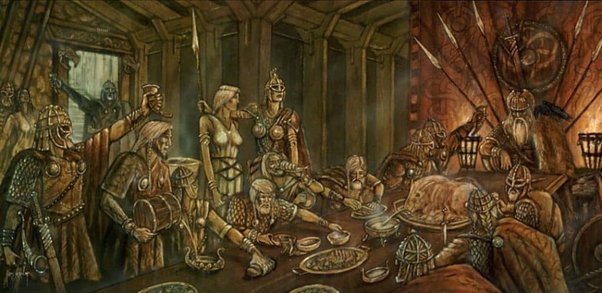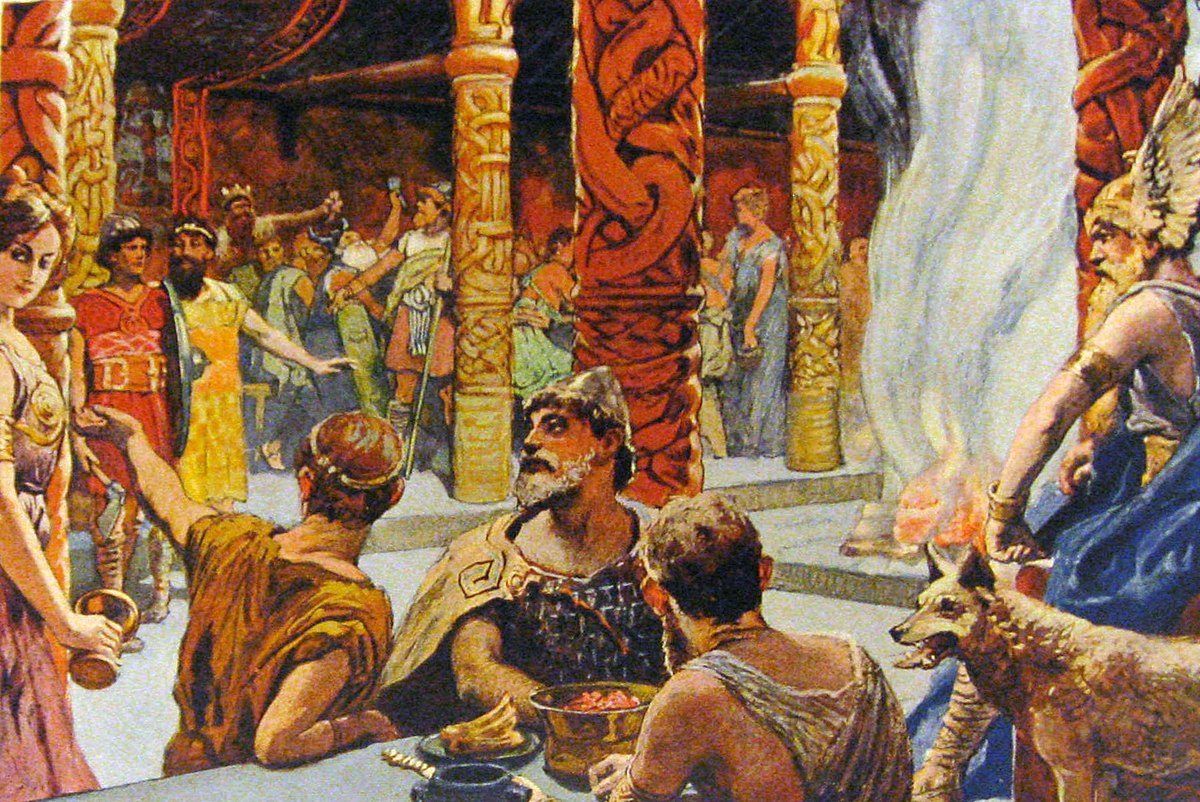In Norse mythology, einherjar are male warriors who died a noble death in battle. The valkyries then carried them to Valhalla slung across their horses, where they would feast and prepare to fight for the Æsir as part of Ragnarök.
Ragnarök was a succession of battles and events that preceded the end of the world. The final stage was a battle at the fields of Vígríðr that pitched gods led by Odin against demons and giants, ending in the destruction of the gods.
Einherjar comes from Old Norse and means “lone fighters.” The plural form of the noun is used almost exclusively except for one documented exception. The rarely used singular form is “einheri.” The pronunciation of einherjar is “ine-hair-yar” with the stress on “hair.”
What Do The Einherjar do in Valhalla?
In Valhalla, the einherjar warriors ate meat from the wild boar Sæhrímnir, which replenished itself every night and the Valkyries served them mead from the udder of the goat Heiðrún.
Becoming an einherjar wasn’t necessarily the preserve of noble warriors. Any criminal, wrongdoer, miscreant, or low-life could end up in Valhalla as an einherjar. It was not how you lived that mattered; it was how you died.
Odin only wanted the best warriors to end up in Valhalla, so he would sometimes use the Valkyries to tip the balance of a fight in the inferior fighter’s favor so the more gifted one would die and become an einheri.

Mentions of the Einherjar In Classic Prose
The einherjar are mentioned in the Vafþrúðnismál, the third poem of the Poetic Edda. It is a conversation recorded in verse between firstly Frigg and the Æsir Odin, and then Odin and the sage jötunn Vafþrúðnir.
Odin thirsts for knowledge and wisdom and hears of the wise giant Vafþrúðnir. He decides to travel to the jötunn’s home under the assumed name of Gagnráðr to see if he can further his education.
In Vafþrúðnismál, Odin and Vafþrúðnir engage in a contest of wits. Odin asks, “where do men fight in Herrjan’s courts every day until the wane of the powers?”
The giant replies thus:
All the Einherjar in Odin’s halls
every day together fight;
the fallen they choose,
and from the conflict ride;
beer with the Æsir drink,
of Sæhrimnir eat their fill,
then sit in harmony together.
Einherjar – Pantheon Org
The Hjaðningavíg
There is a connection between the einherjar and the harii (the Germanic people from 1AD). In the Hjaðningavíg, a heroic Germanic account of a never-ceasing battle, it states any einherjar, wounded or slain while practicing for Ragnarök, are miraculously healed the next day.
Seeing as they are already dead, this fact is maybe not as amazing as it appears.
The Gylfaginning
The Gylfaginning is the first section of the 13th-century Prose Edda. It tells of the birth and annihilation of the world of the Æsir and many other features of Norse mythology. The second and third parts are called the Skáldskaparmál and the Háttatal.
In chapter 20, Snorri Sturluson (1179-1241), the Icelandic historian, poet, and politician, claims that Odin is known as “The Father of the Fallen” because whenever his troops die under his command, they become his adopted sons. He sends them to Valhalla or Vingólf, a house of gods and goddesses.
In chapter 38, the legendary Swedish king Gangleri (sometimes an alias for Odin) mentions that if every fallen hero goes to Valhalla, it must be full of great warriors. Hárr (another pseudonym for Odin) replies that there is indeed a multitude and that many more will arrive. However, it will still be too few when Fenrir appears.
Fenrir was the offspring of Loki and the giantess Angrboda. It was a monstrous wolf, huge and fierce and destined to end the life of Odin during Ragnarök.
Sæhrímnir and Heiðrún
Hárr also mentions that there will always be enough meat from the boar Sæhrímnir and enough mead from the udders of the goat Heiðrún.
Sæhrímnir magically resurrects himself each day to be hunted and cooked for the einherjar to eat. Andhrímnir, the cook of the gods, slaughters and prepares the pork in the cauldron Eldhrímnir.
Heiðrún, in turn, fills a large cask that can never be emptied and inebriates the fallen heroes nightly.
Heithrún, the goat
on the hall that stands,
eateth off Læráth’s limbs;
the crocks she fills
with clearest mead,
will that drink not e’er be drained.
The Poetic Edda – Germanic Mythology
In chapter 41, Gangleri asks Hárr what the einherjar do every day when they are in Valhalla. He replies that they put on their battledress and armor and fight and slay each other in the courtyards.
When dinner time approaches, they ride to Valhalla to drink and eat. That is their favorite way to spend the day.
Lokasenna
Lokasenna (or “Loki’s Verbal Duel”) is another poem in the Poetic Edda. Dating from the 10th century, it is written in a style typical of wisdom verse. In Lokasenna, Loki calls Thor “einheri,” the only occasion there is clear evidence of the singular form of einherjar.
In Helgakviða Hundingsbana I, another poem found in the Poetic Edda, Sinfjötli taunts Guðmundr by telling him he used to be a woman, “a mischievous crone, a giantess, a Valkyrie in Alföðr’s hall.” He claims that every Einheri fought alongside another with only his own interest at heart.
In the poem Hákonarmál in Hákonar saga góða, Odin sent the valkyries Göndul and Skögul to the battlefield to tell the dying king Håkon that he will dwell in Valhalla after his death.
The einherjar are also mentioned in the Prose Edda, written by Snorri Sturluson in the 13th century, the poem Hákonarmál written by the 10th-century skald, Eyvindr Skáldaspillir), and a stanza of an anonymous 10th-century poem paying tribute to the death of Eric Bloodaxe known as Eiríksmál, as compiled in Fagrskinna.
How Many Einherjar Are There?
The Grímnismál is a mythological poem in the Poetic Edda, narrated by a character called Grímnir, one of the many aliases of Odin. It states,
“For the final battle of Ragnarök, 800 Einherjar will march to battle from the 540 doors of Valhalla.”
Encyclopedia Mythica
Einherjar in movies and popular culture
The Master of Ragnarok & Blesser of Einherjar is a Japanese light novel series written by Seiichi Takayama and illustrated by Yuki-san.
It tells the story of Yuuto Suoh, a junior high student who is accidentally transported to Yggdrasil after testing an urban legend by taking a selfie in front of an enchanted mirror. He uses Sun Tzu’s The Art of War and imitates the military strategy and tactic employed by Alexander the Great to become the leader of the Wolf Clan after only two years.
This word also appears in Marvel’s Thor and in various video games, such as Valkyrie Profile. In the Marvel Universe, einherjar are Asgardian warriors.
They are responsible for protecting Asgard and resolving conflicts within the Nine Realms. The einherjar had been in existence since the reign of Bor, the second king of Asgard.
During the cosmic event called the Convergence, Malekith and the dark elves used an ancient weapon called the Aether to return the universe to darkness. Bor led an einherjar army to defeat them.
Einherjar is the name of a short film written and directed by Joshua Hoareau.

